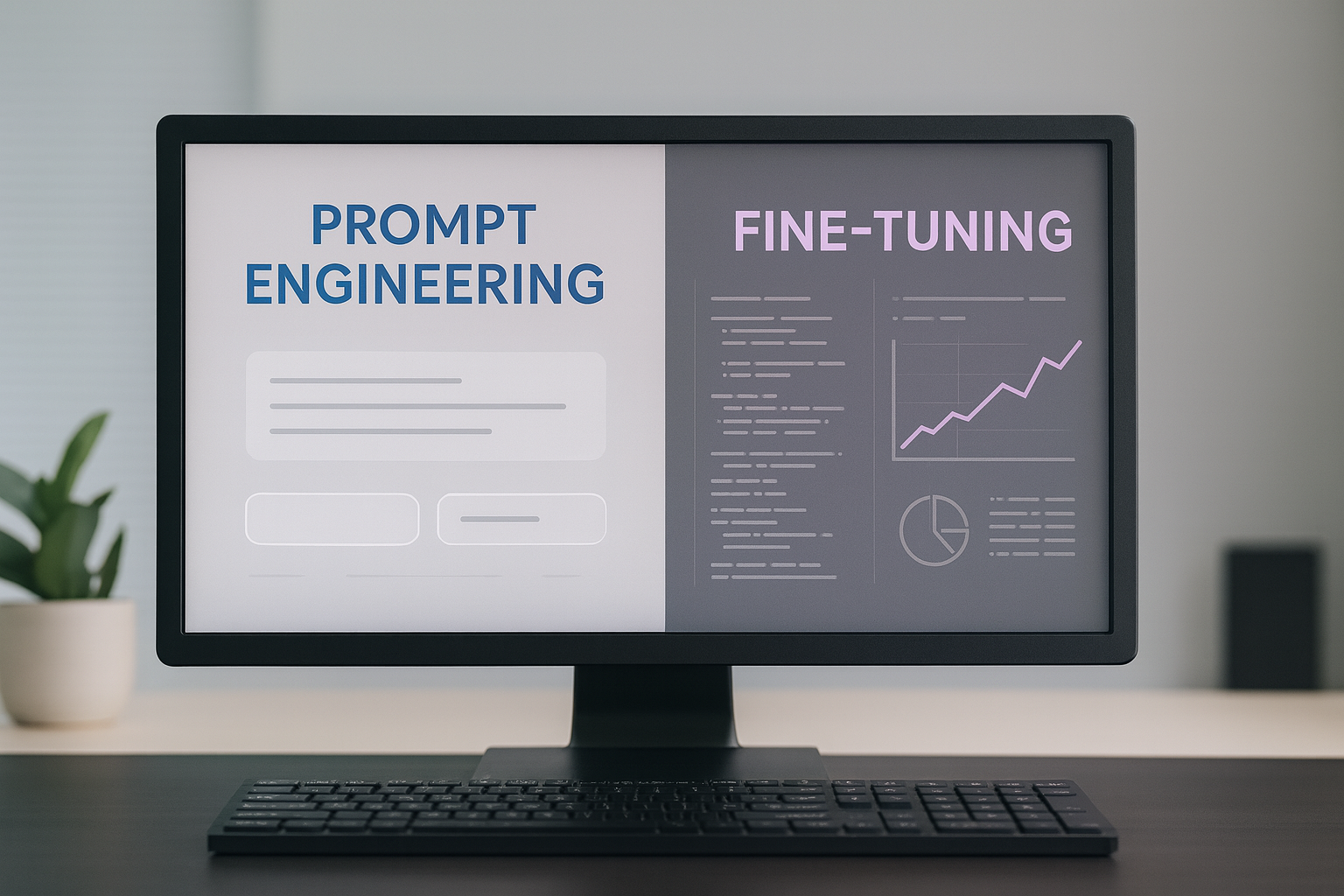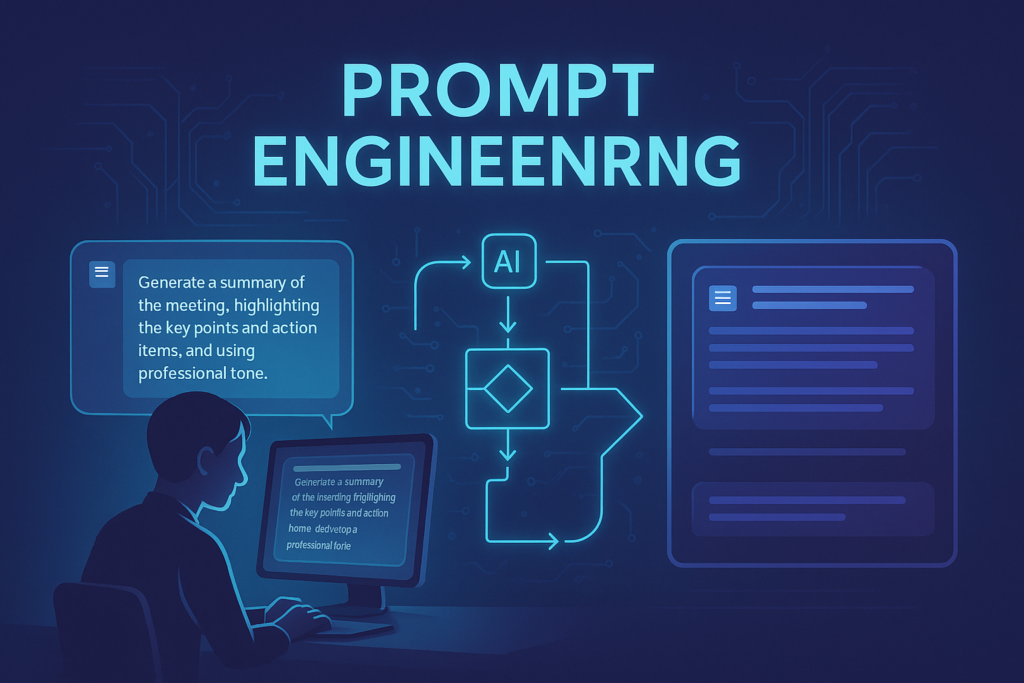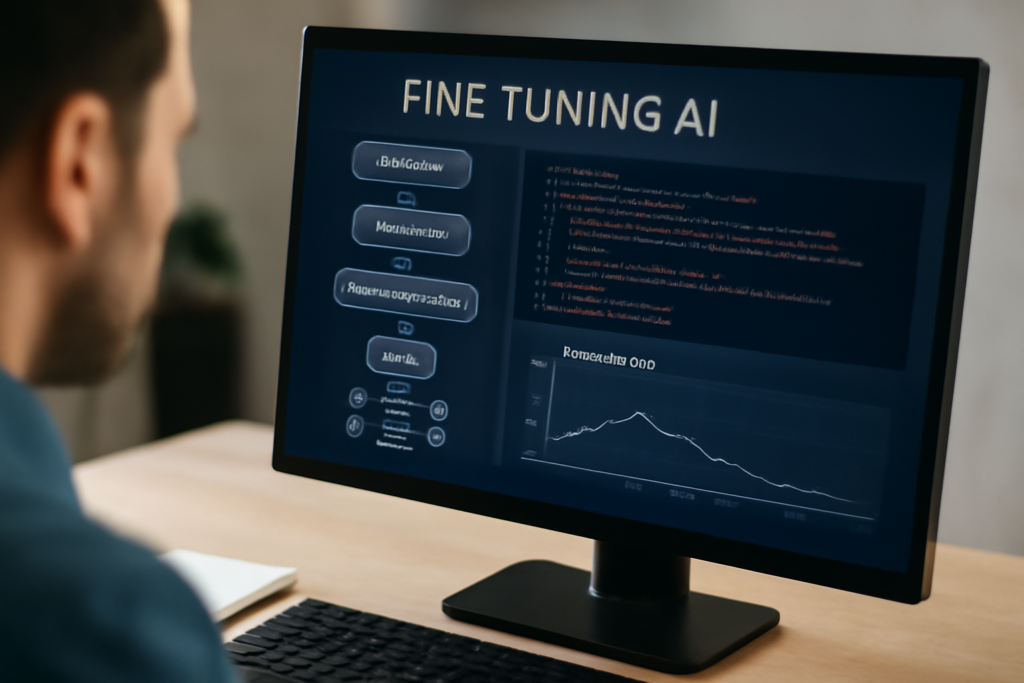Physical Address
304 North Cardinal St.
Dorchester Center, MA 02124
Physical Address
304 North Cardinal St.
Dorchester Center, MA 02124

Have you ever wondered how prompt engineering and fine-tuning AI models are shaping the way we interact with artificial intelligence in 2025? With tools like ChatGPT, Google AI, and countless other applications transforming industries, these two approaches have become the secret weapons behind smarter, faster, and more accurate AI systems.
In simple terms, prompt engineering is the art of crafting precise instructions so an AI delivers exactly what you need—whether that’s answering a complex question, generating creative content, or automating a customer support reply. On the other hand, fine-tuning AI models involves retraining an existing AI with specific data so it learns to excel in a niche or specialized task. Both methods are powerful, but they shine in different situations.
From chatbots that understand your tone to research assistants that can sift through mountains of data in seconds, these techniques power the AI tools we rely on daily. But here’s the big question: when it comes to performance, cost, and results, which works best in 2025—prompt engineering or fine-tuning?
In this blog, we’ll break down each approach, explore real-world examples, and help you decide which strategy fits your needs best in the ever-evolving AI landscape.
Before we compare prompt engineering with fine-tuning, it’s important to clearly understand what prompt engineering is, why it matters in 2025, and how it’s being applied in real-world scenarios. This section will break down the definition, explore the role of a prompt engineer, and share practical examples that show how industries—from customer support to creative writing—are using this skill to get the most out of AI models like ChatGPT and Google AI.

Prompt engineering is all about creating clear and specific instructions, called prompts, to help AI models give the best answers. Unlike traditional AI training, which involves a lot of data and computing power, prompt engineering works with pre-trained AI models, making it quicker and easier. Instead of teaching the AI from scratch, you guide it with simple commands. For example, instead of just saying “Write a description,” you might say, “Write a 150-word description of a coffee mug, focusing on its durability, style, and eco-friendly features.” The more specific your prompt, the better the result!
A prompt engineer is a professional who specializes in crafting inputs that guide AI systems to produce the desired outputs. Instead of altering the underlying structure of the AI, their focus is on refining the way commands or instructions are presented. This often involves working with pre-trained AI models, adjusting prompts to optimize performance across different tasks. While the primary role involves enhancing the efficiency of these systems, prompt engineers may also collaborate with those fine-tuning AI models to ensure the AI can adapt and specialize in specific areas, further improving its accuracy and utility.
Here are a few practical examples of prompt engineering in action:
Many industries use smart prompts to predict actions or make decisions. For example, online stores use AI to figure out what products a customer might buy next, while schools use AI to spot students who might need extra help. These systems work by adjusting the way we ask questions to get the best answers. By using AI models that are already trained, businesses can make these systems smarter and get better insights to help them make decisions.
Now that we know what prompt engineering is, let’s dive into some techniques and best practices to get the most out of AI models like ChatGPT. Whether you’re asking simple questions or more detailed ones, these tips will help you get better results. In this section, we’ll explore basic strategies, advanced methods, and tools available in 2025 to help you improve your skills. These approaches work well with AI models and can also help customize them for specific tasks.
Here are a few practical tips to keep in mind:
Once you’re comfortable with basic prompts, it’s time to explore some advanced techniques that will give you even better results, especially in complex scenarios. These techniques are particularly useful for tasks that require nuanced or multi-step responses.
When using ChatGPT, the way you phrase your prompts can make all the difference. One useful technique is asking ChatGPT to “act” as a specific expert, such as a consultant or teacher. For example, you could say, “Act as a consultant for a new startup. What are the top three tips for getting started with prompt engineering?” This helps set the tone and gives you tailored advice.
Another technique is role prompting. In this case, you ask the AI to take on a specific persona. For instance, “You are a professional copywriter with 10 years of experience in tech. Write a 200-word article about the benefits of prompt engineering.” This allows the AI to provide responses with a particular perspective, ensuring more relevant and high-quality output.
Lastly, chain-of-thought prompting encourages the AI to explain its reasoning before answering. For example, “Explain the key benefits of prompt engineering, and then give examples of how these benefits are applied in real-world scenarios.” This leads to more thoughtful and insightful responses.
In 2025, several tools and platforms are available to help streamline your prompt engineering process, allowing you to work smarter and faster.
By mastering these techniques and tools, you’ll not only improve your prompt engineering skills but also unlock more possibilities for leveraging AI in your personal or professional projects. Whether you’re creating content, automating tasks, or solving complex problems, these strategies will help you get the best results in 2025.

Fine-tuning AI models is a powerful technique used to enhance AI capabilities. While prompt engineering focuses on crafting specific instructions, fine-tuning delves deeper by adjusting a model’s internal parameters to improve its performance for a specialized task. In this section, we’ll explore the basics of fine-tuning, how it compares to pre-trained models, and when fine-tuning is the better choice over prompt engineering.
Fine-tuning involves adjusting a pre-trained model by adding specialized data to improve its accuracy. Instead of just refining how you interact with the model, it changes its internal structure to perform better on specific tasks. For example, in areas like medical diagnosis or legal analysis, fine-tuning helps the model understand the details and improve its performance. Fine-tuning works best when precision is key, especially for complex tasks, while simpler tasks may only need minor adjustments for good results.
Fine-tuning a model typically involves the following steps:
Not all AI models are suitable for fine-tuning. For example, large language models like GPT-3 or GPT-4 are highly adaptable and work well for fine-tuning, while simpler models may not offer the same flexibility. Knowing the types of AI models that best suit your fine-tuning needs is crucial in selecting the right approach for your project.
To master prompt engineering, it’s important to leverage the right resources that will deepen your understanding and enhance your skills. Whether you’re starting from scratch or refining your expertise, there are several valuable materials to guide your journey.
One of the best ways to learn prompt engineering is by following detailed tutorials. OpenAI’s documentation provides clear, step-by-step instructions on how to create effective prompts. For those who prefer a more structured learning path, platforms like Coursera and Udemy offer specialized courses on prompt engineering, helping you understand the nuances of AI models. Check out this tutorial from OpenAI to get started.
For ongoing learning, a good guide will help you understand both basic principles and advanced strategies. Online communities like r/PromptEngineering and AI-focused blogs often share tips and examples that can provide practical insights and speed up your progress in the field.
Several books offer valuable information on prompt engineering and related AI topics. Here are some of the top choices for 2025:
Google is a leader in AI development, and they continuously push forward new ideas and tools related to prompt engineering. They frequently release research papers, tutorials, and tools on their AI Hub. By staying updated with Google’s latest innovations, you can ensure you’re using the most advanced and effective techniques. Additionally, Google’s models like BERT and T5 are crucial for those interested in mastering prompt engineering in natural language processing.
As the demand for prompt engineering continues to rise, there are numerous training and learning pathways to help you develop the skills needed to excel in this field. Whether you are just starting or looking to refine your expertise, 2025 offers a wide range of courses, certifications, and engineering programs tailored to prompt engineering and AI.
For those looking for the best courses in prompt engineering, platforms like Coursera offer structured learning paths. Some of the best courses in 2025 include specialized programs focusing on prompt engineering by Andrew Ng and prompt engineering by Lee Boonstra, which are particularly beneficial for beginners and professionals looking to enhance their skills. You can also find prompt engineering courses free and courses that provide a certificate upon completion. For example, the Coursera Prompt Engineering Specialization is a great option for gaining a comprehensive understanding. You can explore free courses from platforms like OpenAI and Google AI that cover fundamental and advanced prompt engineering techniques.
In addition to courses, prompt engineering certifications are a great way to showcase your skills to potential employers. Certifications help you stand out in a competitive job market, and many platforms offer these qualifications, including AI prompt engineering course benefits that provide the necessary credentials. For those interested in Google’s offerings, their Google prompt engineering course is one of the best resources for staying up-to-date with the latest AI advancements.
When it comes to engineering programs for AI careers, several universities and institutions offer specialized training. Some programs, such as the 3-2 engineering programs, combine undergraduate and graduate-level coursework, preparing students for careers in AI, machine learning, and data science. Ranking engineering programs for AI careers can help you decide which one best fits your future career aspirations. Programs such as those offered by MIT, Stanford, and Carnegie Mellon University are some of the top choices for those pursuing AI and machine learning careers.
In 2025, the decision to choose between prompt engineering and fine-tuning AI models depends on the specific needs of your project. For tasks that require quick deployment and flexibility, prompt engineering often proves more effective. It allows for rapid adjustments without altering the AI’s core structure. For instance, a customer service AI can be adapted through prompt engineering to match the brand’s tone, ensuring that responses align with the company’s voice, without the need for deep model adjustments.
However, for complex or highly specialized tasks, such as medical diagnosis or legal document analysis, fine-tuning may be the preferred option. Fine-tuning involves retraining an AI model with specific, task-relevant data, allowing it to perform with much greater precision. An example of this would be healthcare AI models trained on medical data to provide highly accurate diagnoses, compared to general AI models that are not optimized for these particular use cases.
Often, the best solution lies in combining the two approaches. By blending fine-tuning with prompt engineering, you can create a highly adaptable system that benefits from both specialized training and flexible, dynamic user inputs, ensuring optimal performance across various tasks and industries.
For more insights on how to integrate these approaches, check out this comprehensive guide on prompt engineering vs. fine-tuning AI models for further details and examples.
In 2025, both prompt engineering and fine-tuning AI models are essential in maximizing AI performance. Prompt engineering offers flexibility, allowing users to quickly adjust AI behavior with specific inputs, while fine-tuning involves modifying pre-trained models to handle specialized tasks. The decision between the two depends on the complexity of the task. For general use cases, prompt engineering is effective, but for more specialized applications, fine-tuning AI models delivers better results.
As we move forward, the future of prompt engineering in AI will continue to advance, with innovations improving both model adaptability and efficiency. The integration of fine-tuning and pretrained AI models will help AI systems handle niche tasks while retaining flexibility.
Mastering both techniques will be crucial for AI professionals, enabling businesses to build AI solutions that are both versatile and highly specialized. To stay updated and explore more on these topics, visit icebergaicontent.com for further insights.
Can I learn prompt engineering for free?
Yes, there are many free resources and courses available online to learn prompt engineering. Platforms like OpenAI, Coursera, and YouTube offer tutorials and guides to get started with prompt engineering.
What is prompt engineering?
Prompt engineering is the process of creating specific inputs for AI models to get accurate, relevant, and desired outputs. It involves structuring commands or questions in a way that maximizes AI performance without altering the model itself.
What is fine-tuning AI?
Fine-tuning AI involves adjusting a pre-trained model by feeding it additional, task-specific data to enhance its accuracy and performance for a particular application or domain.
When should I use prompt engineering instead of fine-tuning?
If your task requires quick adjustments and flexibility, prompt engineering is the better option. For more specialized or complex tasks, fine-tuning is preferred as it customizes the model for a specific function.
Are prompt engineers in demand?
Yes, prompt engineers are in high demand as more businesses and industries rely on AI models. The role involves crafting effective prompts and optimizing AI performance, making it a growing field in AI development.
What are the benefits of fine-tuning AI models?
Fine-tuning allows AI models to specialize in specific tasks, improving their performance and accuracy. It’s particularly useful for complex applications like healthcare or legal analysis.